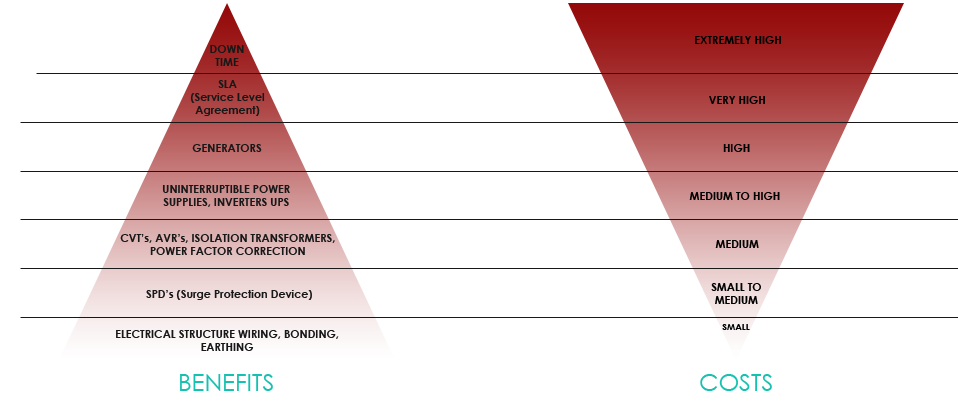Engineering Info & Helpful Tips – Maslow’s Theory

The two triangular principle of Maslow’s theory will help you to access and implement power products that will be beneficial for your particular requirements furthermore; you will achieve a well-engineered power solution.
When engineering a quality power solution the ‘benefit’ vs. ‘cost’ should always be taken into account for the specific application which you are developing for your, business, home or any other application where power is important.
The two triangle principal is quite simple to understand herewith, is a detailed breakdown for each level of the triangles. Keep in mind; every level of the triangle will not necessarily be applicable for your application.
We will start with the base of the ‘BENEFITS’ triangle working upward to the peak.
1. The electrical structure of your installation might seem irrelevant or usually taken for granted that all is okay right?? Wrong!!. Usually, this is where most of your power problems begin. Hence, the base of the ‘BENEFITS’ triangle is absolutely fundamental to the overall efficacy of the power structure and power quality in your building. There is no point in wasting your money on any other part of the ‘benefits’ triangle until the base is properly installed in accordance with SANS 0142 wiring regulations. Electrical cable structure, correct circuit breaker sizes, adequate distribution board, bonding of earth and neutral systems including; earth structures that meet the prescribed loop impedance measurements according to the SANS0142 wiring regulation and in accordance with the OHS act (occupation health and safety) act.
2. Surge protection devices (SPDs) the mythical device that is so often overlooked as an integral part of the quality power solution.
SPD structure is usually not implemented correctly in electrical structures, the basic rule for SPD installation is cascading. Cascading SPD s, what does it mean?? Basically all structures have copper wires entering a building; whether it is electrical or telecommunications, if it runs on a copper wire it is exposed to power surges or natural surges (lightning) and/or common mode noise within the electrical reticulation of the building structure. Cascading, the SANS wiring regulation clearly defines the various electrical ‘ZONES’ and the rating/ class type of SPDs that should be installed within these ‘ZONES’ of the electrical structure, similarly there are SPD structures that are implemented for the telecommunication/IT/ network systems.
3. The next step-up within the ‘benefits’ triangle, CVT, AVR, PFC & isolation transformers are usually not considered by the UPS (uninterruptible power) sales person. Either they do not understand the clients need or the client does not express what he really wants from the piece of hardware which will adequately protect, support, reduce his electrical bill or back-up his equipment. I have been involved in the UPS industry for 27years, it never ceases to amaze me that the client has bought or has been advised to buy the wrong product for his application. Either the sales person is not asking for enough info from the client or the client is just adamant that a UPS will always fix the problems, this is just not true! This lack of knowledge or understanding could lead to further precipitation of his power problems. Herewith, is an example of the client buying the wrong product? The client has a laboratory with sensitive equipment , the problem; the sensitive equipment, freezes, hangs or just crashes for no apparent reason, the client doesn’t necessarily want back-up, he just wants the power issue sorted-out, what should he buy?? The chances are he doesn’t need a UPS (uninterruptible power supply) why?? Because he mentioned that back-up is not an issue. So what is causing the problem, there is a myriad of problems within his network that could cause this problem. Let’s assume the ‘BENEFITS’ triangle has been implemented correctly from the base up okay!! This starts to narrow down the problem. Common mode noise or disruption from another piece of equipment situated close to the sensitive equipment could be the culprit causing the problems, in this instance, I would suggest the client install an isolation transformer, not a double wound transformer, there is a distinct difference.
4. Uninterruptible power supply; the humble UPS and inverter, this is where things get even more confusing, why?? There are literally three topologies of UPS /inverters however, there are so many different names given to each of the various technologies, these names are usually made-up by UPS companies for marketing purposes. How do you know what you are buying?/ how do you know if it is the correct UPS/inverter for my application?/ Literally, you don’t; you are in the hands of the UPS/inverter sales person!! Herewith, are the three UPS topologies
Off-line – the cheapest entry level type UPS systems, small application products
Line – interactive sine wave – the midrange UPS system adequate for most small to medium applications.
True on-line double conversion – the highest level of UPS technology, used in small to high powered applications.
Inverters - modified sine wave cheap entry level inverters medium rated chargers, suitable for small application, long run times.
Inverters - sine wave, usually high powered transformer based including high powered integral charger, suitable for small to medium applications, long run time.
The line-interactive sine wave & on-line UPS system can also be fitted with a long run option charger.
The fundamental difference between a UPS & inverter is the DC bus voltage ie. The lower the DC bus the more likely it is an inverter. A more subtle difference is the communication ports, Generally UPS incorporate various communication ports such as RS232, RS485, MODbus, dry contacts and SNMP whereas, inverters do not have any form of communications ports. In order to buy the correct product for the application it is imperative to give as much information to the sales person as possible, info such as, the type of load, how critical is the load, the environment, the external environmental condition ie. Where the business is situated, heavy industrial area or office park area, all these factors are relevant when buying a UPS/inverter system.
5. Generators, generally used in conjunction with an uninterruptible power supply, not usually used in conjunction with an inverter. Sizing the generator is the most subjective detail for the correct size generator rating without over sizing. Over sizing the generator has two consequences, unnecessarily high capex costs and high running/maintenance costs. Of course there are other issues such as, diesel vs. petrol, silent canopy, weather proof canopy, automatic start-up (STS, AMF panels), three phase or single phase systems, generator exhaust and legal issues regarding additional fuel stored onsite.
6. SLA, service level agreements, the grudge purchase. Unfortunately, a necessary evil. Once you have bought your expensive, UPS, inverter, CVT, AVR or generator set how do you manage to keep this expensive item in top working order, for the instance, how do you know it will function correctly when it is required to perform?? The SLA gives this peace of mind, after buying the actual product the last thing you want to consider is buying an SLA to look after and manage this expensive piece of equipment unfortunately, the SLA is a necessity when considering the chain of requirements to secure a high level of continuous quality power. To justify the SLA consider; what is the cost of downtime during a power outage or the cost of repair to your sensitive equipment if any of the power support structure fails.
7. Finally, even though the downtime is indicated in the ‘benefits’ triangle when it is clearly not a benefit, I wanted to make the point that the small peak of the triangle could be made smaller and smaller depending on the installation and management of the relevant ‘benefit’ levels that are implemented as part of the continuous, quality of supply and security of your power.
The items I have briefly discussed above are an overview of the basic requirement to ensure continuous quality power to secure the uninterrupted energy that your company requires to operate at an optimum level.
If you would like any further information regarding any of the ‘BENEFIT’ levels please don’t hesitate to contact us, thank you.





